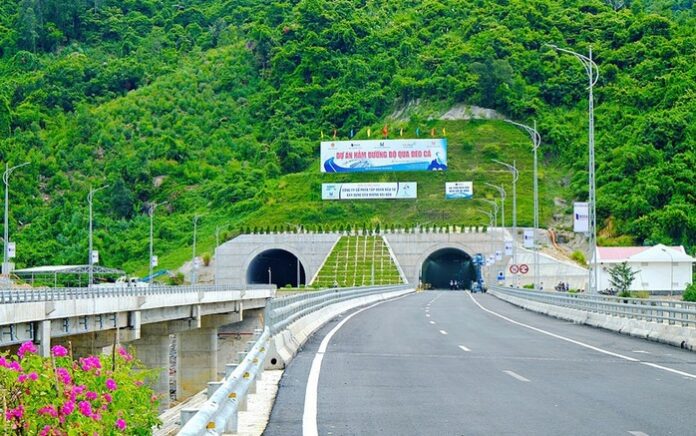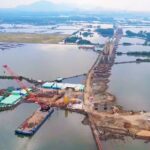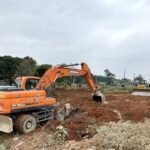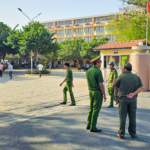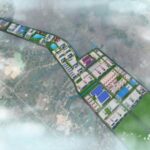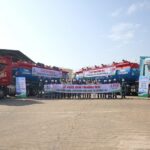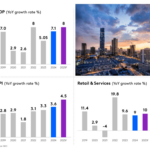Proposed Solutions for 11 Struggling BOT Traffic Projects
The Ministry of Construction has issued Document No. 7356/BXD-CDBVN, a draft decree detailing solutions to the obstacles faced by BOT traffic projects. This draft has been sent to related ministries, sectors, and provincial/municipal People’s Committees for feedback.
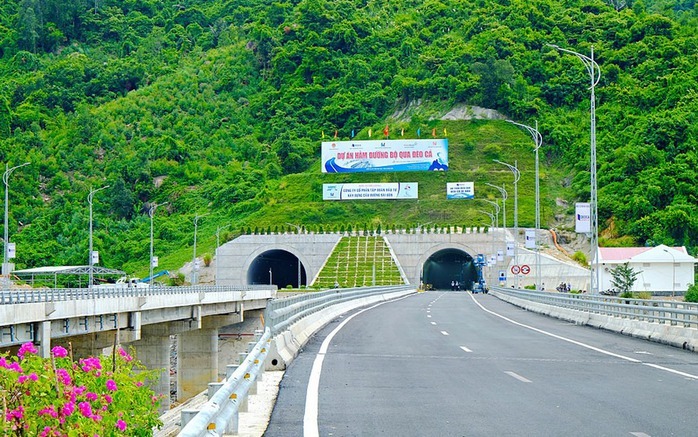
The Deo Ca Tunnel construction project is one of the 11 BOT traffic projects proposed for definitive handling.
The draft consists of 13 articles in 3 chapters: Chapter I (Articles 1-3) covers general provisions; Chapter II (Articles 4-8) deals with addressing revenue shortfalls for BOT traffic projects signed before January 1, 2021; and Chapter III (Articles 9-13) focuses on terminating contracts for BOT traffic projects signed before that date.
According to the Ministry of Construction, before 2020—when the Law on Investment in the Form of Public-Private Partnership (PPP Law) was issued—the country had mobilized approximately VND 318,857 billion for 140 construction investment projects under the Build-Operate-Transfer (BOT) traffic model. These projects have effectively contributed to socio-economic development, reducing transportation costs, easing traffic congestion and accidents, and enhancing the economy’s competitiveness.
However, the laws on BOT investment prior to the PPP Law had certain limitations. During the implementation of these contracts, policy adjustments were necessary to align with practical requirements, leading to challenges in some BOT traffic projects.
Following the conclusions of the National Assembly Standing Committee and the directions of the Government, the Ministry of Construction (formerly the Ministry of Transport) collaborated with local authorities to comprehensively assess the difficulties and obstacles faced by BOT traffic projects nationwide. As a result, out of the total 140 BOT projects, 11 projects have been identified as facing quantifiable obstacles, with several others potentially facing similar issues.
Based on this assessment, the Ministry of Construction, in coordination with the State Bank of Vietnam and relevant local authorities, negotiated with investors and project enterprises to agree on two groups of solutions to address the challenges. These solutions adhere to the principle of “harmonious interests and shared risks,” involving either the state sharing to continue the contract or compensating for early contract termination.
Proposed Solutions for the 11 BOT Traffic Projects
Regarding the issue of addressing revenue shortfalls for BOT traffic projects signed before January 1, 2021, the draft decree clarifies the ratio of sharing the reduced revenue. Specifically, the state’s sharing ratio is determined to be no more than 75% of the average ratio between the reduced revenue and the revenue in the project’s financial plan over the last three years. The reduced revenue is calculated by subtracting the actual revenue from the revenue in the financial plan.
In the case of early termination of PPP traffic project contracts signed before January 1, 2021, the draft decree proposes that investors and project enterprises be compensated according to the provisions of Point a and Point b, Clause 2a, Article 52 of the PPP Law. This applies when one of the following two conditions is met:
1. The project has been in operation for at least two years, but the investor or project enterprise has not been allowed to collect tolls for capital recovery as per the project contract.
2. The project has experienced a revenue shortfall, and the parties have recalculated the financial plan based on additional state capital sharing, reduced equity interest rates, and reduced loan interest rates, but the toll collection period for capital recovery still exceeds 50 years.
In the draft submission for this decree, the Ministry of Construction mentions one more issue related to the handling of BOT projects that requires the Government’s opinion. This pertains to the compensation for early termination of contracts, specifically regarding the interest expense during the operation and business phase of BOT projects. The Ministry of Construction is currently considering three options for this matter.
Option 1: Total loan amount as per the contract multiplied by the interest rate (determined as 4%/year). The time frame for calculating interest expense starts from when the project/work is put into operation until the contract termination decision is made.
Option 2: Total interest expense that the investor or project enterprise has paid to the credit institution up to the time the competent authority decides to terminate the contract.
Option 3: Zero VND (excluding interest expense during the operation and business phase from the compensation for early termination of the contract).
List of the 11 BOT traffic projects facing difficulties and obstacles that need to be addressed:
– 8 projects under the authority of the Ministry of Construction:
-BOT National Highway 1 Project, Thanh Hoa City Bypass (including the eastern bypass and the western bypass from Km0 to Km6);
-Project to build the Thai Nguyen – Cho Moi (Bac Kan) road and upgrade National Highway 3, Km75 – Km100, under the BOT format;
-BOT Project to upgrade and expand Ho Chi Minh Road, Km1738+148 – Km1763+610;
-BOT Project to improve and upgrade National Highway 91, Km14 – Km50+889;
-BOT Project to improve and upgrade the Saigon River route from Binh Loi Bridge to Ben Suc Port;
-BOT Project to construct the Viet Tri – Ba Vi Bridge;
-BOT Project to construct the Thai Ha Bridge;
-BOT Project to construct the Deo Ca Tunnel.
3 projects under the authority of local provinces/cities:
-Bac Giang – Lang Son Expressway Project under the BOT format (Lang Son Provincial People’s Committee);
-BOT An Hai Bridge Project (Phu Yen Provincial People’s Committee, now Dak Lak Provincial People’s Committee);
-BOT Project to improve and upgrade National Highway 39B and the Thanh Ne Town bypass (Thai Binh Provincial People’s Committee, now Hung Yen Provincial People’s Committee)
The City of Ho Chi Minh: A Tale of Two Scarcities – Land and Resettlement Housing.
The lack of residential land available for resettlement purposes has significantly hindered the compensation process and delayed the handover of project sites.
KBC Subsidiary Pours in Massive Capital for the Loc Giang Industrial Park Project, Totalling Nearly VND 5.2 Trillion
The Loc Giang Industrial Park spans an impressive 466 hectares and is strategically located in the communes of Loc Giang, An Ninh Dong, and Tan My, in Duc Hoa District, Long An Province. The mastermind behind this development is none other than Saigon Northwest Urban Development Joint Stock Company, a powerhouse in the industry.






















